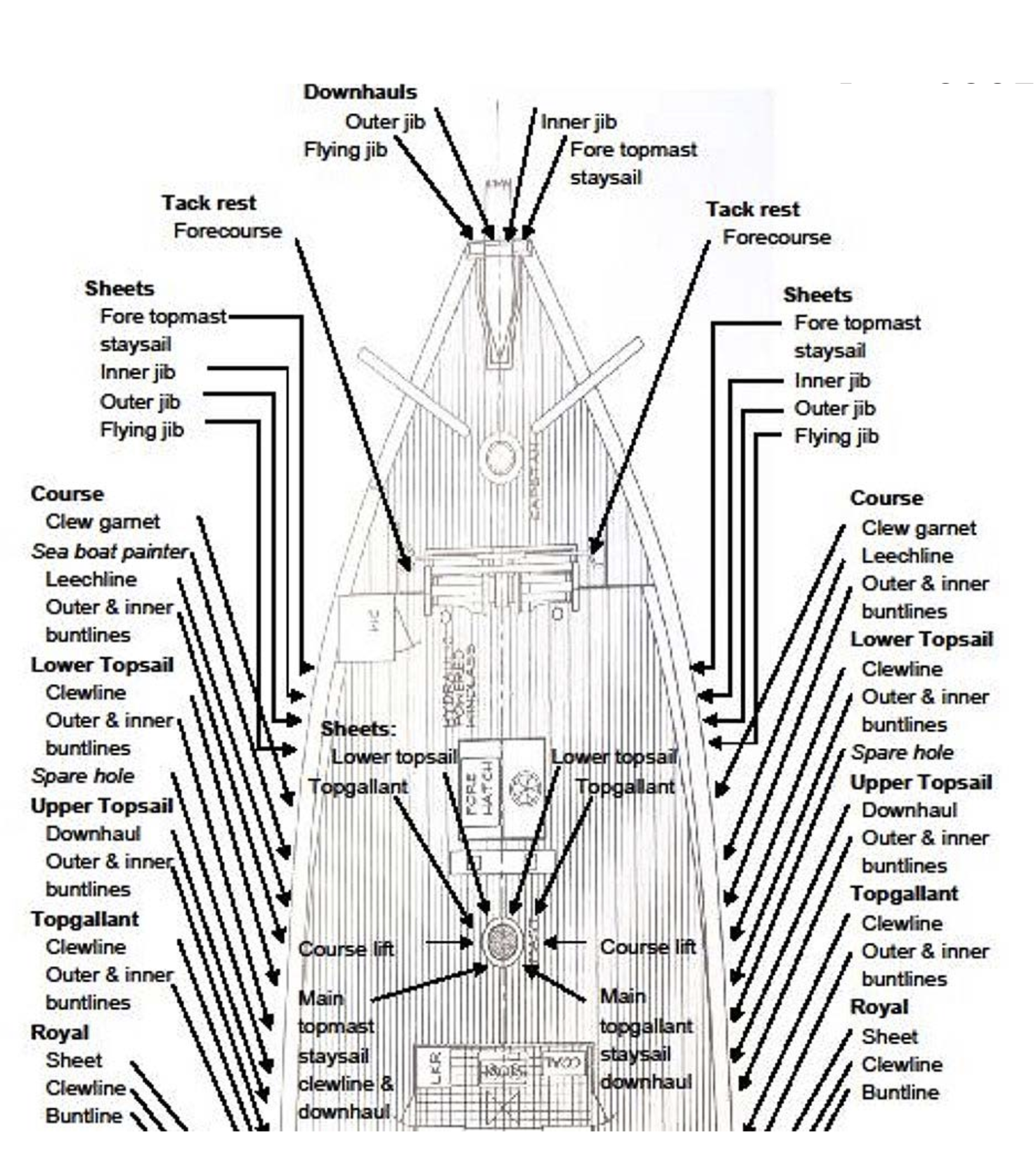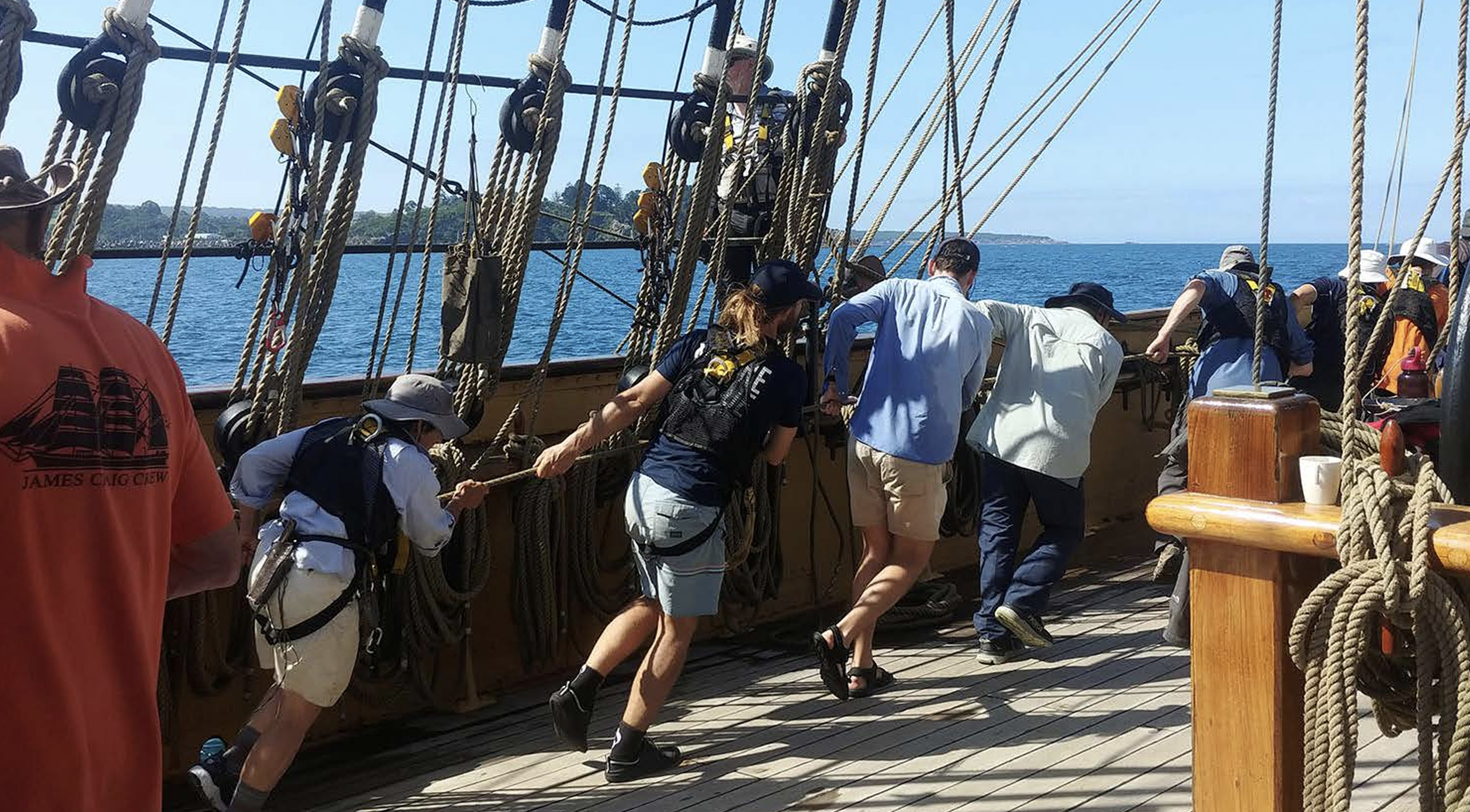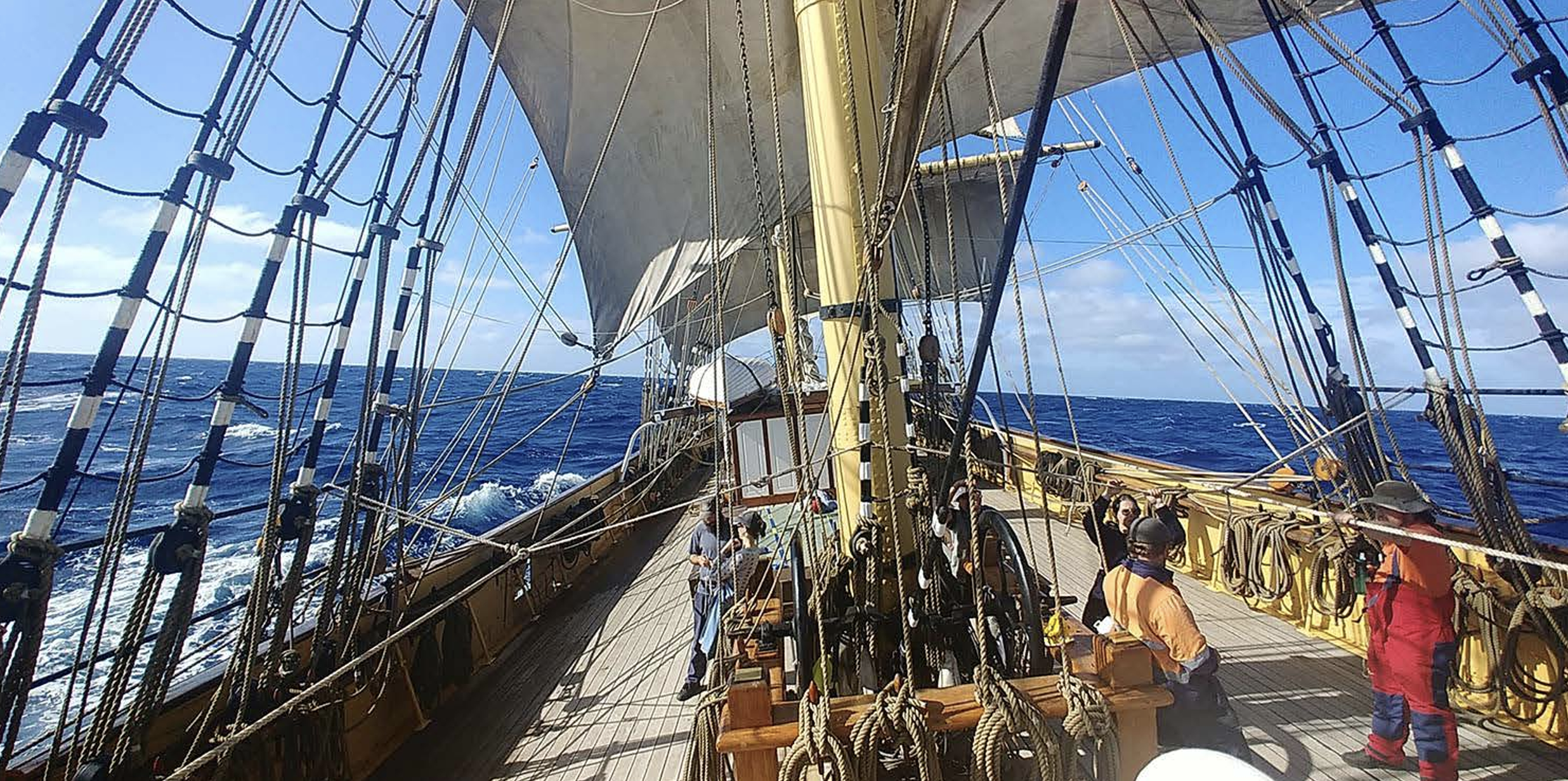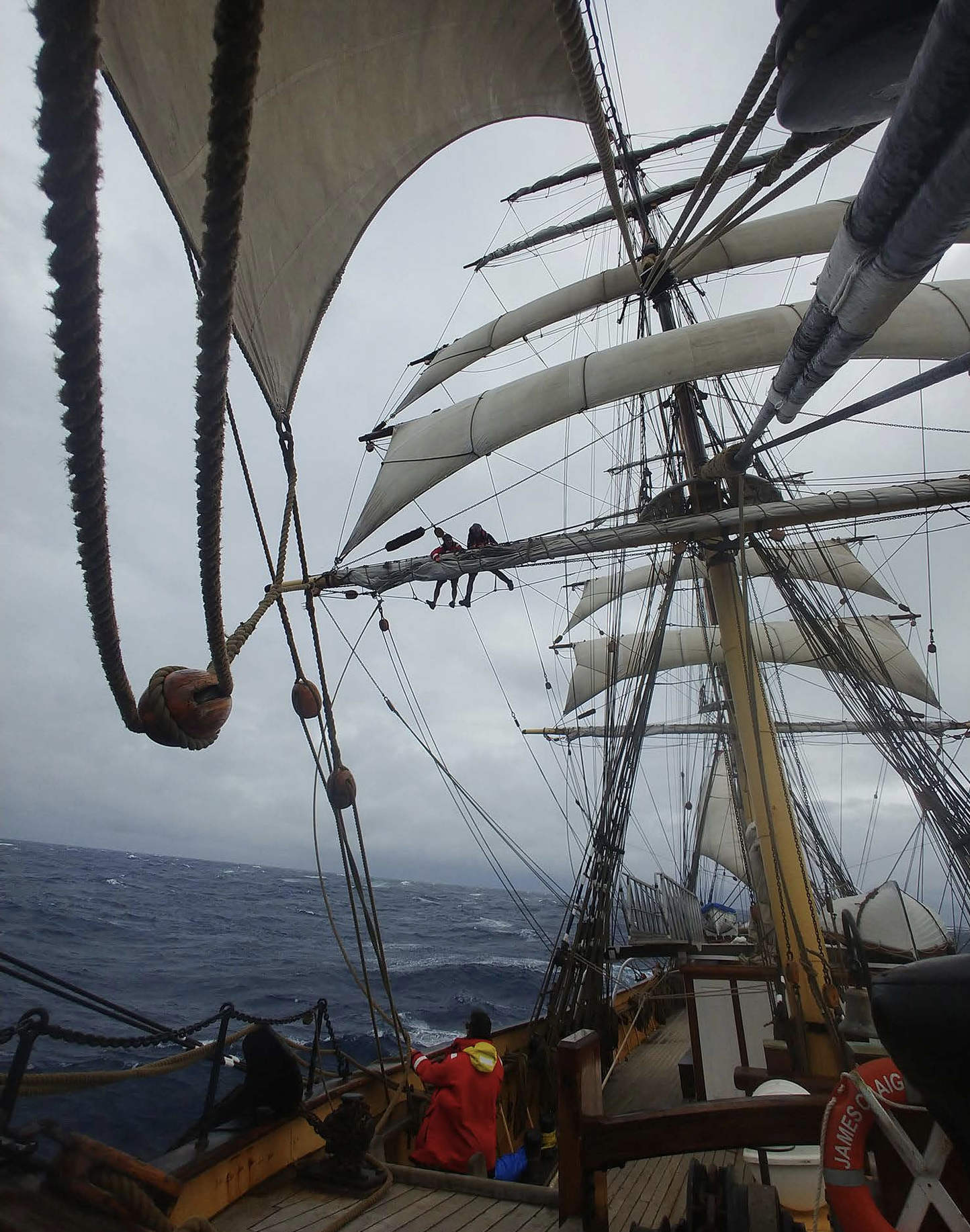21 SAILS SET — FULL AND BYE
This Article by Peter Scott first appeared in the June edition of the Sydney Amateur Sailing Club’s Newsletter
(Photos Peter and Sarah Scott unless otherwise indicated)
Whilst cruising up to Port Stephens in 35 knots of wind last October, the Hobart wooden boat festival was being discussed. I asked Clinton “What sort of adventure can you have in Tassie after the festival?” “Well here’s an idea,” he said. “I’m sailing back to Sydney on James Craig — they might have room for more passengers.” Sound of my head exploding Wow, that would be fantastic; Sarah and I were on the wait list two days later. With three weeks to go one of us was booked and I said to Sarah that she should go, but she said that I should go, so I called the SHF office and said I was experienced in tall ships, having made three voyages previously. Another week went by and then the call — if I could do three days training prior to sailing I could go as crew! James Craig operates as a training ship and, whilst some are learning new skills, others are volunteering to repair the rig, hull and deck. There are people training in all aspects of maritime work from masters certificates through to riggers and marine engineers and for me, the climbing certificate. First, however, I had to learn the ropes — after 50 years sailing you might have imagined this would be easy. There are 21 sails on the Craig and a dozen other parts of the ship operated by manual efforts and ropes. A total of approx 260 ropes belayed to pins around the rails and masts of the mid deck, foredeck and quarterdeck. To sail the ship you have to learn the ropes.
James Craig putting Cherub into perspective-Photo John Jeremy
Two weeks later I joined ship in Hobart during the festival, Craig was there to entertain the crowds and earn her keep. Volunteers at all crew levels, from master to caterers made sure that everyone was safe and having a good time. Tugs towed the ship off the wharf, crew went aloft to set sail, bells were rung and others explained the history and parts of the ship to make a show of it. Sarah joined ship two days later, she would be a passenger and there was to be no fraternising. She reverted to crew at the first opportunity. We were put in the mizzen watch and started working to prepare the ship for the voyage.
James Craig has plenty of ropes to learn
Day 1: The crew and passengers totalled 68 persons of all ages, everyone lent a hand to stowing gear, fixing hammocks, clearing the museum layout, retrieving gantry’s, handing down box after box of food, taking on water, bending sails, folding awnings, battening down the main hatch, preparing lines, fire patrols, safety drills, climbing out the jib boom, learning how to put on a harness in the dark and make no noise, hanging blackout curtains and the as the sun started to lower — off to the pub to get a good feed and a last drink for ten days.
No lack of opportunities for good exercise
James Craig at sea
Day 2: A cold night sleeping on the stretcher, breakfast was great then all hands on deck. Tug alongside, pass out the towline, a heavy rope thicker than my forearm. Lines brought on board walked out along the deck, coiled on palettes. A light westerly wind and warm day as the ship motored SE into Storm Bay. Sails were set for exercising the crew, the watches started; the bosun and engineers worked on gear around the ship and mizzen watch were on the first dog. Several pods of dolphins raced up to the ship in the late afternoon, the MOB drill launched the seaboat and the dolphins danced to where the retrieval dummy had floated away. As we approached Tasman Island the sun lowered and the colours changed to night. A green glow over Bruny Island was the Southern Lights wishing us fair winds.
Dolphins putting on a show
Day 3: East Coast doldrums as we motor sailed towards the Furneaux Group. Ship life consisted of a four-hour watch every 12 hours, training, safety, meals, plenty of food, sketching. Quiet times to practice skills aloft, I was mentored in using the harness and had to climb to the first platform three times using double clips initially and an ascender on the last circuit. At 61 years I thought I would be the oldest aloft, not even close, two of the most skilled Topmen were in their late 70s and one was a woman.
Life in a square-rigger — all in a day’s work
Day 4: James Craig needs at least 20 knots of wind to really get sailing, however, we were still only getting 10–15 knots from the SE. The forecast was for a stronger SW wind and as the sun set over Flinders Island the dark clouds and wind arrived. So too did a fierce electrical storm as all around us the sky lit up, nowhere to go but off across the Strait and over the largest waterfall in the world as the depth changed from 30 m to 3000 m.
Day 5: 30–35 knots, 3–4 m following sea, beautiful sailing conditions. The ship came alive, the master asked for as much sail as she could carry so about 15 sails were set, three headsails, eight square sails and four staysails. We kept to our watch tasks, fore and stern lookouts, quartermaster to take the wheel, Captain’s runner, fire patrols and the hardest job of all — Peggy, the galley help.
Day 6: Averaging 8 knots, lifelines rigged, the SW wind moved to the South and eased into the East. We were joined by a three-masted yacht running up to the Whitsundays. Dolphins, gannets, flocks of mutton birds, an albatross kept us company as we approached and rounded Gabo Island, heading into Eden for a day to wait out the NE wind.
Day 7: Shore leave for those that wanted to test their sea legs. Eden is finding itself to be a sought-after stopover for cruise ships and yachties with a wonderful antique store and good coffee. On return to the ship the games had begun, heaving line accuracy, water-bucket filling and safety harness on and off.
Day 8: A strong Southerly powered us, rolling up the coast, lifelines rigged, shipping wave crests and keeping our watch focussed on the job. Maluka flashed past that night on her way back to Sydney and then off to race in the Fastnet. That morning, with 15 sails up, we were just coming off watch when a call came in — a boat had capsized offshore, four crew were in the water and we were the closest vessel. “All hands, all hands, we are going to take off all sail and motor back to aid the rescue.” In 15 mins we performed a Rapid Sail Reduction. The rescue helicopter got there before us of course but it did a close 360 around us as a friendly thank you.
Day 9: Back on course, that night showed us all the stars, and a beautiful sunrise as we approached Wollongong, the SE wind was dropping and off the quarter, just right to set all sails. The crew were ecstatic, 21 sails is a rare event and the pride in the achievement was felt by everyone aboard. As the sun set we entered the harbour and prepared to anchor in Rose Bay.
The engineers lugged out their BBQ and that night we had a special meal on deck with beer and then a performance of the Sods Opera — who knew we had so many talented performers aboard! Day 10: We awoke to a gentle sun-filled Rose Bay with a tinge of sadness as we knew that we were soon to disembark. Not until we had cleaned and prepped the ship and weighed anchor, of course. We motored towards the Bridge and the order was to dress ship, all climbing hands aloft. My climb took me higher than I had been previously, up the rat lines, past the futtocks, up Jacobs ladder and stepping out on the upper t’ gallant yard, about thirty metres above the deck.
The voyage had been full of wonders — phospheresent seas, the life within the ocean, and our life in service to the ship — new friends, new skills and lots of stories. James Craig is 150 years old next year and she is still training young sailors in the ways of the sea.
James Craig under full sail-SHF photo
The James Craig is part of the Sydney Heritage Fleet+61 2 9298 3888
info@shf.org.au
Wharf 7, 58 Pirrama Road, Pyrmont NSW 2009









